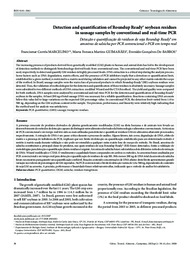Detection and quantification of Roundup Ready soybean residues in sausage samples by conventional and real-time PCR.
Detection and quantification of Roundup Ready soybean residues in sausage samples by conventional and real-time PCR.
Autoria: MARCELINO, F. C.; GUIMARÃES, M. F. M.; BARROS, E. G.
Resumo: The increasing presence of products derived from genetically modified (GM) plants in human and animal diets has led to the development of detection methods to distinguish biotechnology-derived foods from conventional ones. The conventional and real-time PCR have been used, respectively, to detect and quantify GM residues in highly processed foods. DNA extraction is a critical step during the analysis process. Some factors such as DNA degradation, matrix effects, and the presence of PCR inhibitors imply that a detection or quantification limit, established for a given method, is restricted to a matrix used during validation and cannot be projected to any other matrix outside the scope of the method. In Brazil, sausage samples were the main class of processed products in which Roundup Ready® (RR) soybean residues were detected. Thus, the validation of methodologies for the detection and quantification of those residues is absolutely necessary. Sausage samples were submitted to two different methods of DNA extraction: modified Wizard and the CTAB method. The yield and quality were compared for both methods. DNA samples were analyzed by conventional and real-time PCR for the detection and quantification of Roundup Ready® soybean in the samples. At least 200 ng of total sausage DNA was necessary for a reliable quantification. Reactions containing DNA amounts below this value led to large variations on the expected GM percentage value. In conventional PCR, the detection limit varied from 1.0 to 500 ng, depending on the GM soybean content in the sample. The precision, performance, and linearity were relatively high indicating that the method used for analysis was satisfactory.
Ano de publicação: 2008
Tipo de publicação: Artigo de periódico
Unidade: Embrapa Gado de Leite
Palavras-chave: GMO, PCR quantitative, Sausage, Transgenic residues
Observações
1 - Por padrão são exibidas publicações dos últimos 20 anos. Para encontrar publicações mais antigas, configure o filtro ano de publicação, colocando o ano a partir do qual você deseja encontrar publicações. O filtro está na coluna da esquerda na busca acima.
2 - Para ler algumas publicações da Embrapa (apenas as que estão em formato ePub), é necessário ter, no celular ou computador, um desses softwares gratuitos. Sistemas Android: Google Play Livros; IOS: iBooks; Windows e Linux: software Calibre.
Acesse outras publicações
Acesse a Base de Dados da Pesquisa Agropecuária (BDPA) para consultar o acervo completo das bibliotecas da Embrapa.

